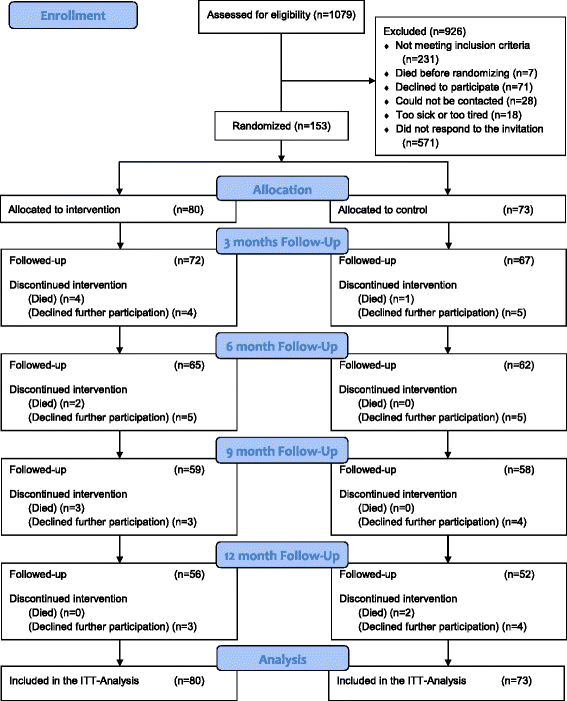Cost-utility analysis of case management for frail older people: effects of a randomised controlled trial
- PMID: 26054487
- PMCID: PMC4449349
- DOI: 10.1186/s13561-015-0051-9
Cost-utility analysis of case management for frail older people: effects of a randomised controlled trial
Abstract
Background: To evaluate the effects of a case management intervention for frail older people (aged 65+ years) by cost and utility.
Materials and methods: One hundred and fifty-three frail older people living at home were randomly assigned to either an intervention (n = 80) or a control group (n = 73). The 1-year intervention was carried out by nurses and physiotherapists working as case managers, who undertook home visits at least once a month. Differences in costs and quality-adjusted life years (QALYs) based on the health-related quality-of-life instruments EQ-5D and EQ-VAS, and also the incremental cost-effectiveness ratio were investigated. All analyses used the intention-to-treat principle.
Results: There were no significant differences between the intervention group and control group for total cost, EQ-5D-based QALY or EQ-VAS-based QALY for the 1-year study. Incremental cost-effectiveness ratio was not conducted because no significant differences were found for either EQ-5D- or EQ-VAS-based QALY, or costs. However, the intervention group had significantly lower levels of informal care and help with instrumental activities of daily living both as costs (<euro>3,927 vs. <euro>6,550, p = 0.037) and provided hours (200 vs. 333 hours per year, p = 0.037).
Conclusions: The intervention was cost neutral and does not seem to have affected health-related quality of life for the 1-year study, which may be because the follow-up period was too short. The intervention seems to have reduced hours and cost of informal care and help required with instrumental activities of daily living. This suggests that the intervention provides relief to informal caregivers.
References
-
- Case Management Society of America. Standards of Practice for Case Management. 3rd revised ed. Little Rock: Case Management Society of America; 2010.
-
- Björkman T. Case management for individuals with severe mental illness: a process-outcome study of ten pilot services in Sweden [PhD thesis]. Lund: Lund University; 2000.
LinkOut - more resources
Full Text Sources
Other Literature Sources


